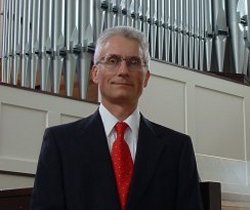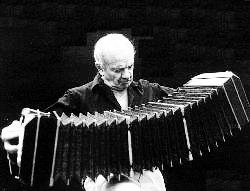
| | Organist | Accordionist | Composer | Conductor | Author | Educator |

 |
Henry Doktorski
|
 |
April 2004: Henry Doktorski appeared with the Pittsburgh Symphony Chamber Orchestra (Nuance) in a performance of Astor Piazzolla's Le Grand Tango on Saturday, April 17, 2004 at the Katz Auditorium of the Jewish Community Center in Pittsburgh, Pennsylvania. The work was conducted by Maestro Andr s C rdenes, artistic director of the Nuance Chamber Music Series and concertmaster of the Pittsburgh Symphony Orchestra; the cello solo was performed by the PSO's principal cellist, Anne Martindale Williams.

Astor Piazzolla Le Grand Tango was composed by the great Argentinean bandone nist and composer Astor Piazzola (born 1921 in Mar de Plata, died 1992 in Buenos Aires) as a commission for the Russian cellist, Mstislav Rostropovich. The piece, in its original form for piano and cello, was premiered in 1990 by Rostropovich, and is arranged in three distinctive sections. The first section (Tempo di tango) combines strong rhythmic elements with modern dissonances and popular song-like melodies. The second (Meno mosso: libero e cantabile) is an eloquent but melancholic dialogue, and the last (Piu mosso: Giocoso) is a fiery, rhythmic dance-like tour de force for the cello and orchestra.
The chamber orchestra version of Le Grand Tango, arranged by Howard Williams and published by Berben Edizioni Musicali of Ancona, Italy, is scored for solo cello, flute, oboe, two clarinets, two horns, two trumpets, trombone, tuba, piano, percussion, strings, and accordion.
Doktorski explained, "The accordion is featured prominently in this chamber orchestra version of Le Grand Tango. The instrument is used primarily for its distinctive reedy timbre, which adds essential color to the orchestra. Williams uses the instrument to perform three different functions. First, he uses it melodically, as in the Meno mosso section where it plays beautiful melodies. Second, he uses it rhythmically, to emphasis syncopated accents with the percussion, and third, he uses it as a filler to sustain long background chords. The accordion plays frequently in the piece (compared to some other pieces with orchestra I've played which have tested my concentration by making me count hundreds of measures of tacet) and sometimes I have to keep the dynamic level subdued in order not to detract from the other instruments, especially the solo cello, which is what the piece is really about. Williams writes often for the left-hand manual of the accordion, and he seems to understand the instrument. My favorite part is a solo left-hand figure in the third section which doubles the double basses, and of course, the brilliante descending chromatic run at the finale."
Maestro C rdenes spoke about the importance of the accordion in the chamber orchestra version of Le Grand Tango, "This piece can't happen without the accordion. The genesis of the tango features the bandone n, or in our case, the accordion, which is a nice substitute for the original free-reed tango instrument: the bandone n. The essential elements of a correct tango interpretation are threefold: one needs (1) an extremely accurate and passionate sense of rhythm, (2) the bandone n or accordion, and (3) a great violinist. Although Piazzolla expanded and elaborated on the original tango ensemble in his Tango Nuevo (he wrote for cello, viola, chamber groups, etc.), the pioneers of the genre, like Carlos Gardel, for instance, used the bandone n (or accordion). I can hardly imagine a tango without this instrument."
|
see Contact Henry Doktorski. |
| Back
to The Homepage of Henry Doktorski |